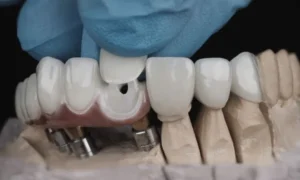We would like to inform you about the 2 most popular types of crowns used in aesthetic dentistry. This guide will be the best comparison about Porcelain crown vs zirconia crown.
You will learn the differences between the two clearly and you will be able to decide accordingly. In order to explain the difference between zirconia crown and porcelain crown more clearly, it is worth considering both separately. We prefer to tell you about both crowns in detail and leave the decision to them.
What is the difference between Porcelain crown vs zirconia crown?
Porcelain crown is a structure that does not break easily, and no matter how long it passes, it never loses its shine. Metal backing, light proof. It may be preferred for diastema problems, which are mostly in the front teeth, turned and disfigured teeth, tooth coloring, broken or worn teeth.
Zirconium tooth crown content does not contain metal. Zirconium is the closest application to the natural tooth from an aesthetic point of view. They can be preferred on both front teeth and back teeth.
Zirconia crown has high tensile strength. It is also often preferred because of its aesthetic posture, texture harmony, robustness and naturalness.
Porcelain crowns are also known as metal-backed ceramic crowns. Therefore, metal bridges to support ceramics are preferred in this technique. Porcelain crowns offers both a dull and matte appearance as it reflects the image of the metal at the bottom.
As the underlying metal oxidizes over time, it also leads to problems such as discoloration of the gums. Because the Metal infrastructure is not compatible with the gum, after a while, openings appear on the gum borders, and food accumulates in this part.
It needs to change every 8-10 years. Zirconium is a semi-metal. It has light transmittance. Because it directly reflects the color of the tooth itself, it has a natural appearance.
It has an extremely high harmony with the gum and prevents the formation of food residues in the teeth. You have teeth that you can use for many years. It is a slightly higher cost method than porcelain crown.
Zirconia Crowns vs Porcelain Crowns: Which is Better for You?
Porcelain crowns are applied only to the front surface of the tooth, without cutting from the tooth or with minimal cutting. It is applied to the teeth one by one. In zirconium, enough cuts are made to accommodate the thickness of the substance.
Zirconium is a durable and aesthetic substance. Recently, due to its knowledge of processing, it has also been used in different areas. Computer aided systems have expanded the use of zirconium. Basically, there are deciduous differences between laminated and zirconium.
It is placed only on one side of the laminated tooth. According to the application can be called 1/4, 1/3 crown. Zirconium is restorations applied around the tooth.
The application of laminated teeth is applied to the front surface of the teeth and offers minimal material removal with porcelain leaves attached to the tooth. The leaves can be prepared in the desired colors, sizes and shapes.
In practice, very little tissue is taken from the tooth without damaging the gum. In this sense, laminated application is a form of preventive treatment. In some cases, it is applied without any etching from the tooth
Zirconia Crowns vs Porcelain Crowns: Differences, Benefits, and Costs
When it comes to dental restorations, choosing the right material for crowns is crucial for both aesthetics and functionality. Zirconia and porcelain crowns are two popular options, each with its own set of characteristics. This guide will explore the differences, benefits, and costs associated with zirconia and porcelain crowns to help you make an informed decision.
Differences Between Zirconia and Porcelain Crowns
- Material Composition
- Zirconia Crowns: Made from zirconium dioxide, a durable and biocompatible ceramic material. Zirconia is known for its strength and fracture resistance.
- Porcelain Crowns: Typically crafted from ceramic materials that mimic the appearance of natural teeth. Porcelain can be fused to metal or used as a full ceramic option.
- Appearance
- Zirconia Crowns: Often more opaque, making them less translucent than natural teeth. However, advancements in technology have improved their aesthetic appeal.
- Porcelain Crowns: Highly translucent and can be color-matched to natural teeth, providing a more natural look, especially for front teeth.
- Strength and Durability
- Zirconia Crowns: Extremely strong and resistant to wear, making them ideal for molars and areas subjected to heavy biting forces.
- Porcelain Crowns: While also durable, they are generally more prone to chipping compared to zirconia, especially in cases of heavy grinding or clenching.
- Procedure and Fit
- Zirconia Crowns: Typically require less tooth reduction and can be digitally designed for a precise fit using CAD/CAM technology.
- Porcelain Crowns: May require more tooth reduction, especially if fused to metal, to achieve the desired strength and appearance.
Benefits of Zirconia Crowns
- High Strength and Durability
- Ideal for patients with strong bite forces or those needing crowns on molars.
- Biocompatibility
- Less likely to cause allergic reactions or gum irritation.
- Less Tooth Reduction
- Preserves more of the natural tooth structure.
- Advanced Technology
- Precision fit with digital design and milling processes.
Benefits of Porcelain Crowns
- Natural Aesthetics
- Excellent translucency and color-matching capabilities for a natural look.
- Versatility
- Suitable for both front and back teeth.
- Proven Track Record
- Long history of successful use in dental restorations.
- Minimal Allergic Reactions
- Metal-free options reduce the risk of metal allergies.
Costs of Zirconia vs. Porcelain Crowns
- Zirconia Crowns Cost
- Generally more expensive due to the material’s strength and advanced manufacturing process.
- Costs can range from $1,000 to $3,000 per crown, depending on the dental clinic and geographic location.
- Porcelain Crowns Cost
- Costs can vary widely, with porcelain-fused-to-metal crowns typically being less expensive than all-porcelain options.
- Prices range from $800 to $2,500 per crown, influenced by the complexity of the case and the type of porcelain used.
Is porcelain crown cheaper than zirconia crown?
Crown types are selected by investigating the most appropriate method for the patient after everyone has researched and made the necessary Analyses. Currently, the Most Preferred Dental crowns are porcelain crowns and zirconium crowns.
It is applied by dentists by selecting the structure of the tooth and the type of crown suitable for the budget. When performing tooth crown treatment, the doctor first measures the entire or necessary part of the tooth.
Superstructure works are made of materials such as metal supported porcelain, zirconium, and metal non-supported porcelain within the dimensions. Dental crowns is performed in 2-4 Sessions. First, the teeth are reduced and rehearsals are performed after measurements are taken.
After tooth crowns are made, sensitivity to hot and cold may be experienced for some time. But over time, this sensitivity disappears. When price comparison is made, it is possible to say that porcelain crowns are cheaper than zirconium crowns.
What are the advantages and disadvantages of zirconia crowns?
Zirconium is a white, hard ceramic material and is one of the few new materials that combines the strength of metal with the aesthetic, tooth-like appeal of porcelain. The performance of zirconium coatings is constantly being improved. They are natural and durable.
Although zirconium has a closer resemblance to a real tooth than gold and other metals, it actually has a more opaque appearance. Although durability is one of the many advantages of zirconium, there are times when the tooth should be less strong.
For example, if your dentist needs to adjust the coating to coincide with your closing, or if he needs to erode the coating because it begins to damage the natural tooth, the strength of zirconium can be considered a disadvantage.







